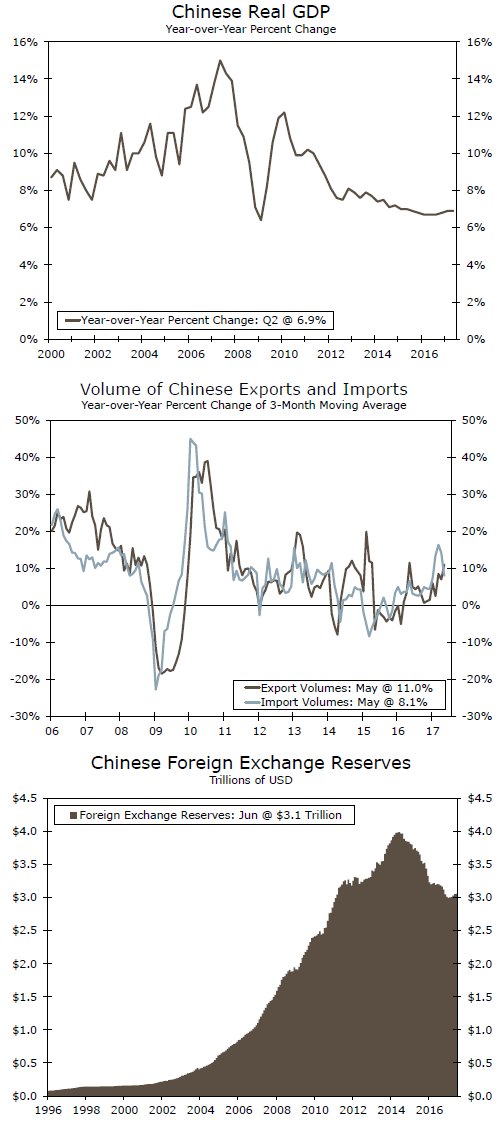Chinese real GDP growth modestly topped expectations in Q2. Amid an improving outlook for the global economy, Chinese economic growth and capital outflows have stabilized for the time being.
Chinese GDP Growth Steady in Q2
Data released today showed the Chinese economy growing 6.9 percent on a year-ago basis in Q2, topping expectations by 0.1 percentage point and matching the year-over-year pace from Q1 (top chart). Over the past few quarters, China’s economy has very modestly accelerated; after three consecutive quarters of 6.7 percent year-over-year growth to start 2016, the year-ago pace ticked up to 6.8 percent to cap the year and has climbed another tick thus far in 2017.
Although a breakdown of GDP into its demand components is not yet available, sector level data indicate that growth was steady in the key sectors of the Chinese economy. Growth in the secondary industry, which includes mining/quarrying, manufacturing, construction and utilities production, held firm at 6.4 percent on a year-over-year, year-to-date basis. Growth in the tertiary industry, or the service sector, was also unchanged at 7.7 percent over this period. The primary sector, which includes agriculture, forestry and fishing, was the sole mover and shaker in Q2, accelerating to a 3.5 percent pace year-over-year, year-to-date.
Economic growth in China has stabilized alongside the brightening outlook for global trade. Indeed, growth in Chinese export volumes has improved from the weak pace seen over the past couple years (middle chart). Separate data released this morning showed Chinese industrial production topping expectations in June on both a year-over-year and year-to-date basis. Investment spending growth, which has accounted for much of the slowdown in the Chinese economy over the past few years, has also leveled out as Chinese policymakers try to thread the needle in challenging areas such as housing; on a year-ago basis, fixed investment spending growth has held steady at 8.6 percent for the past three months.
Although the prospects for the Chinese economy have improved of late, we do not expect a return to the supercharged rates of growth in the global economy experienced over the past couple expansions. As such, we look for a gradual, secular deceleration in the Chinese economy ahead.
Capital Outflows Halted, Gradually Stronger Yuan in the Outlook
Capital outflows plagued the Chinese economy for much of 2014-2016 amid fears about future growth in the world’s second largest economy. FX reserves dipped below $3.0 trillion in January 2017 for the first time since 2011 as Chinese policymakers tried to staunch the bleeding. Midway through 2017, however, Chinese policymakers appear to have successfully righted the ship for the time being. Since that low reached in January, FX reserves have modestly increased in each successive month (bottom chart). Our currency strategy team sees a relatively steady renminbi in the near term, and moderate strength in the renminbi versus the U.S. dollar over the medium term amid a broadly softer outlook for the greenback.















